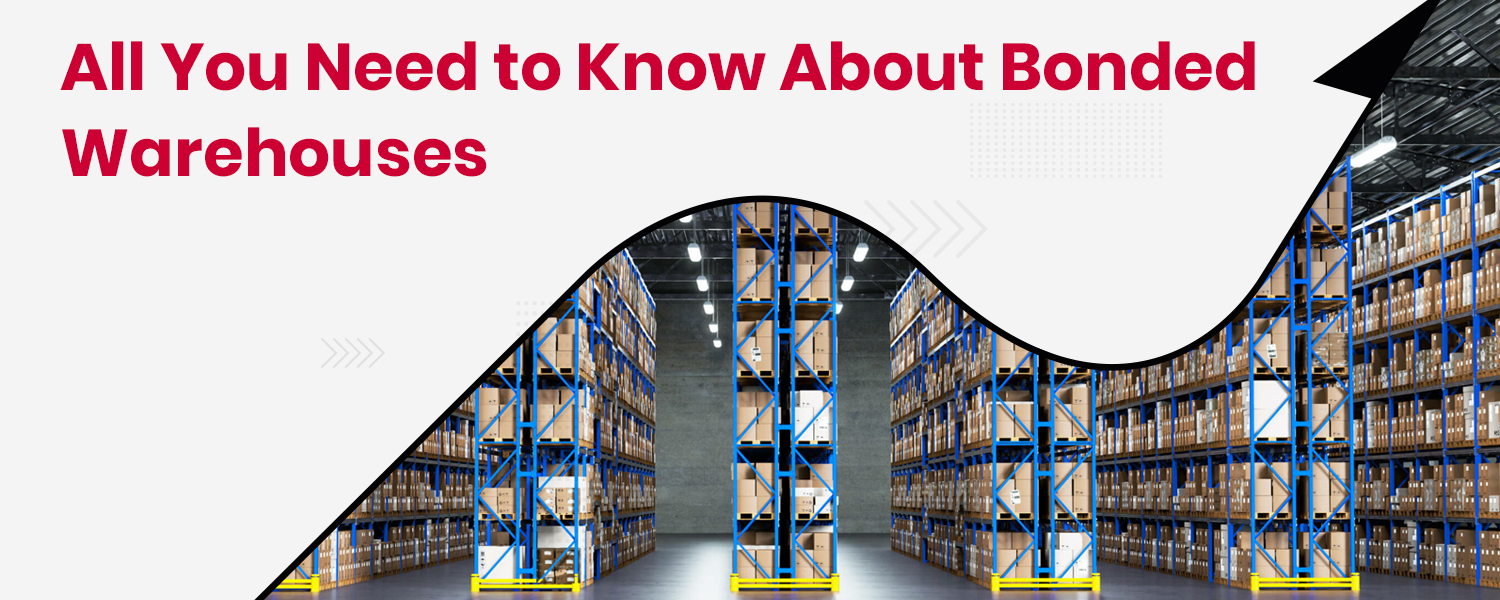Imagine a vault of opportunity, where goods from across the seas sit patiently, untouched by any duties and taxes, awaiting their entry into the market. Bonded warehouses, acting as that vault of opportunity, emerge as a cornerstone, offering businesses a powerful tool under the complexities of international trade. In eCommerce, understanding bonded warehouses becomes a critical component rather than a mere exercise in logistics.
In this blog, let’s discuss what makes these warehouses a strategic hub that can pivot an eCommerce business’s cash flow and operational dynamics. From their workings, types, and substantial benefits to choosing the right bonded warehouse partner and overcoming challenges, this guide promises to equip you with everything you need to know about bonded warehouses.
Understanding What a Bonded Warehouse is
In its most fundamental sense, a bonded warehouse is one of the types of warehouses sanctioned by customs authorities, specifically designed to house imported goods without the immediate burden of import duties or taxes. This financial respite, a form of fiscal grace, allows businesses to store goods in limbo – within the country yet free from the immediate clutches of any type of customs duty.
In international trade, bonded warehouses stand as pivotal waypoints. They are critical cogs in the logistics machine, smoothing the path for goods as they transition across borders. These warehouses serve a dual purpose – they are safe havens where goods rest and rejuvenate and strategic launchpads from which businesses can propel their products into the market with financial agility.
How Bonded Warehouses Work?
Inbound Logistics
This phase involves coordination between suppliers and bonded warehouse providers, where each plays a crucial role. Suppliers must ensure that goods are ready for transit. On the other hand, the bonded warehouse providers prepare to receive these goods, aligning their resources and schedules to ensure a seamless transition.
Receipt of Goods
The goods enter a crucial verification phase upon arrival at the bonded warehouse. The initial documentation check is the first line of defense in ensuring compliance with customs clearance. This step involves scrutinising the Bill of Lading, Import License, and other relevant documents accompanying the goods.
Storage in the Bonded Facility
Once the goods pass through the initial reception phase, they are ushered into the bonded warehouse’s storage area.
Different Features of Bonded Warehouse
Long-Term Storage
Bonded warehouses stand out for their ability to offer prolonged storage periods, significantly longer than traditional warehousing solutions. It allows businesses to respond flexibly to market demands without the pressure of rapid turnover or the financial burden of immediate duty payments. This aspect is especially advantageous for seasonal goods, high-value items, or products awaiting market entry.
Safety and Security
Safety and security are paramount in bonded warehouses, given the value and nature of the goods stored. These warehouses have advanced security protocols, including surveillance systems, restricted access, and stringent inventory control measures to protect against theft, damage, or loss.
Deferred Duties
Businesses can store their goods without paying duties until they are ready to release them into the market. This financial advantage gained through customs duties and tax deferral can lead to substantial cost savings.
Convenient International Shipping
Bonded warehouses act as intermediary points where goods can be stored, managed, and processed before being shipped to their final destination, thus facilitating smoother global trade operations. Businesses that export goods provide a staging ground for consolidating shipments, completing necessary documentation, and ensuring compliance with export regulations.
Proximity to Ports
The strategic location of bonded warehouses, typically near major ports and transport hubs, is a significant advantage. It allows for quick and easy movement of goods in and out of the warehouse, reducing the time and cost associated with transportation.
How Bonded Warehouse is Different from Non-Bonded Warehouse
Customs Duties and Taxation
In bonded warehouses, the significant advantage is the deferral of customs duties and taxes. Goods can be stored for an extended period without paying duties, offering substantial cash flow benefits to businesses engaged in international trade. On the contrary, non-bonded warehouses require immediate payment of all duties and taxes upon receiving goods, leading to higher upfront costs for businesses.
Storage Duration and Restrictions
Bonded warehouses offer extended storage durations, sometimes up to several years, allowing businesses to manage their inventory more effectively without the pressure of immediate duty payments. In contrast, Non-Bonded Warehouses typically have limitations on storage duration and are generally more flexible regarding the types of goods they can store.
Regulatory Compliance and Oversight
Bonded Warehouse operations must adhere to strict regulatory guidelines and are often subjected to frequent customs audits to ensure trade laws and regulations compliance. However, non-bonded warehouses have comparatively relaxed regulatory requirements, focusing more on standard warehousing protocols than customs compliance.
Usage and Suitability
Bonded warehouses are particularly suited for international trade, import-export businesses, and storing goods that require duty deferral. They are an ideal choice for businesses dealing with international suppliers or customers. In contrast, non-bonded warehouses are typically used for domestic storage and distribution, catering to businesses that require regular warehousing services for locally distributed goods.
Cost Implications
Using a bonded warehouse can lead to significant cost benefits related to the deferral of duty payments, offering businesses a strategic financial advantage. On the other hand, using a non-bonded warehouse involves immediate duty payments, which can impact a business’s overall warehousing costs.
Types of Bonded Warehouses
1. Public Bonded Warehouses
Public bonded warehouses, typically government-owned or operated, are general-purpose facilities accessible to multiple businesses. These warehouses offer a broad range of standard storage solutions, making them ideal for eCommerce companies seeking cost-effective and efficient warehousing options. They are particularly beneficial for businesses that do not require specialised storage conditions but need a secure and reliable space for their goods under customs control.
2. Private Bonded Warehouses
Private bonded warehouses are owned and operated by private entities and are often tailored to meet the specific needs of individual clients. These warehouses are a go-to option for eCommerce businesses with unique storage requirements, such as those dealing with niche products or requiring additional security and care. They offer higher control over inventory management and are preferred by companies seeking personalised services, including specialised storage conditions, enhanced security measures, or specific handling protocols.
3. Temporary Storage Areas
Temporary storage areas are designed for short-term storage needs, strategically located near ports or transportation hubs for quick and efficient transit. These facilities are particularly suited for eCommerce businesses dealing with fast-moving inventory or requiring immediate storage solutions during transit.
4. Specialised Bonded Warehouses
Specialised bonded warehouses cater to specific categories of goods, such as perishables, hazardous materials, or high-value items. These warehouses are essential for eCommerce businesses dealing with products that require unique storage conditions, such as controlled temperatures, secure environments, or specialised handling. They provide the necessary infrastructure and expertise to ensure sensitive goods’ safe and compliant storage.
5. Bonded Logistics Parks
Bonded logistics parks represent large-scale, integrated facilities that offer a combination of storage, logistics, and other related services. These extensive complexes benefit large eCommerce companies that require a comprehensive range of services, including storage, fulfilment, and distribution, all in one location.
Integrating Bonded Warehouses in eCommerce Logistics
The integration of bonded warehouses into eCommerce logistics requires a strategic approach tailored to the unique needs of the business. For instance, an eCommerce business specialising in imported luxury goods might prioritise bonded warehouses for their duty deferral benefits, while a business dealing in fast-moving consumer goods might focus more on warehousing’s ability to streamline its supply chain.
A successful integration also hinges on the seamless interplay of technology and operational processes. Modern eCommerce logistics rely heavily on technology for inventory management, order processing, and tracking. Integrating bonded warehouse operations into this technological framework requires a robust Warehouse Management System (WMS) that can communicate with the business’s existing eCommerce platforms.
Benefits of Bonded Warehousing for eCommerce
- When goods are stored in a bonded warehouse, the requirement to pay customs duties and taxes immediately is postponed. This deferral translates into significant cost savings for eCommerce businesses.
- Bonded warehouses offer extended storage options, allowing businesses to store products for longer periods without the burden of immediate duty payments.
- By storing goods closer to their final market or point of distribution, businesses can significantly reduce the time it takes to move products from the warehouse to the customer.
- Bonded warehouses offer unparalleled security and risk mitigation, which is crucial for eCommerce businesses dealing with valuable, fragile, or sensitive products.
Choosing the Right Bonded Warehouse Partner
Before finalising your bonded warehouse partner, consider the following factors:
Location Considerations
Selecting the right location for a bonded warehouse is critical for any eCommerce business. The ideal warehouse should be strategically positioned near major transportation networks, ports, and land routes. This proximity is a vital component that significantly impacts logistics efficiency. A well-located warehouse can dramatically shorten delivery times, reduce shipping costs, and streamline logistics.
Facilities and Equipment
The infrastructure of a bonded warehouse is another cornerstone in the selection process. A warehouse equipped with modern facilities and robust equipment is essential for the safety and security of stored goods. It’s not just about having a space to store products; it’s about ensuring they are protected, preserved, and prepared for distribution under optimal conditions. Additionally, the warehouse must comply with industry safety, security, and control standards.
Flexible Solutions
Your warehouse partner should offer adaptable storage solutions that align with your business’s growth and evolving needs. This flexibility can manifest in various forms, from scalable storage space to customisable service options. It’s about finding a partner who can provide tailored services that drive efficiency and support your specific business strategies.
Customer Service
Having a warehouse partner with 24/7 customer service is invaluable. This round-the-clock support ensures that any issues or emergencies can be addressed promptly, minimising potential disruptions to your supply chain.
Expertise and Industry Experience
The experience and expertise of a warehouse partner are non-negotiable. Choosing a partner with a proven track record in managing logistics operations, particularly within the retail and eCommerce industry, is essential. This expertise ensures that the warehouse is well-versed in eCommerce logistics’ unique challenges and intricacies.
Warehouse Layout and Flow
The design and layout of a warehouse play a significant role in operational efficiency. A well-planned warehouse layout optimises storage space, streamlines retrieval, and enhances overall operational performance.
Conclusion: Use NimbusPost’s Advanced Warehouse and Fulfilment Centres
The need for robust and strategic warehousing solutions becomes increasingly apparent as the eCommerce industry continues to evolve and expand. For eCommerce businesses looking to elevate their logistical operations, streamline their supply chains, and provide exceptional customer service, leveraging NimbusPost’s advanced warehouses and fulfilment centres presents an opportunity that cannot be overlooked.
NimbusPost’s tech-enabled solutions, strategically located worldwide, offer a seamless blend of efficiency, speed, and reliability, crucial in today’s demanding retail landscape. By partnering with NimbusPost, you can tap into a network of state-of-the-art warehouses and fulfilment centres designed to meet the specific demands of the online retail sector. Reduced shipping costs, faster delivery times, and a marked decrease in product returns represent a tangible impact on customer satisfaction and business growth.




